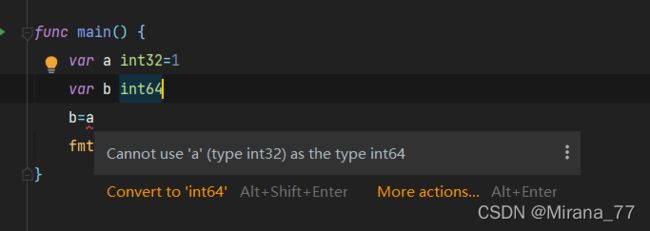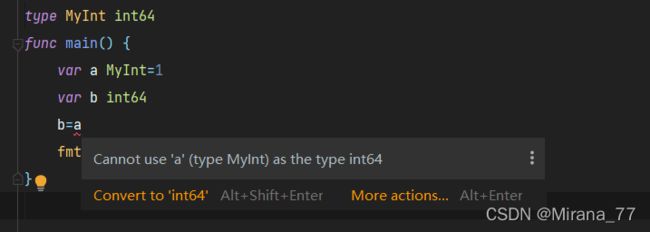Go语言基础_数据类型、基本语法篇
Go语言基础
Go的数据类型
基本数据类型
- 布尔型bool
- 字符型string
- 整型int int8 int16 int32 int64
- unit unit8 unit16 uint32 unit64 uintptr
- 字节型byte
- rune
- float32 float64
- complex64 complex128
与其他语言的差异
- Go不支持隐式类型转换
- 别名和原有类型也不能进行隐式类型转换
示例
错误の示例1
错误の示例2
类型的预定义值
在math包下,有int、float、unit,直接使用即可
指针类型
支持使用指针直接访问内存空间
与其他语言的差异
- 不支持指针运算
- string是值类型,默认的初始化值是空字符串,不是nil
示例
使用示例
func main() {
a:=1
aPtr:=&a
fmt.Println(a,aPtr)
//%T获取变量类型
fmt.Printf("%T %T",a,aPtr )
}
######################################
1 0xc000128058
int *int
Process finished with the exit code 0
差异の示例1
差异の示例2
func main() {
var s string
fmt.Println("*"+s+"*")
fmt.Println(len(s))
}
######################################
**
0
数组和切片
Map
与其他语言的差异
- 获取不存在的key不会报空指针(参考java),会根据value的类型返回默认值,比如int是0,string是 nil。此时不能简单的通过nil判断key是否存在,但是可以主动判断key是否存在
- map的value可以是一个方法
- 与go的dock type接口方式一起,可以实现单一方法对象的工厂模式
示例
map的声明
//map[key type]value type
map1:=map[string]int{"one":1,"two":2}
map2:=map[string]int{}
map1["one"]=11
//make(type,capacity),map跟切片都是自增长度的存储,如果容量不够,就会分配新的内存空间然后把原来的值进行拷贝。如果我们提前就知道了map的容量,那么就可以使用map初始化,避免因为频繁扩容带来的开销,提高性能
map3:=make(map[string]int,10)
fmt.Println(map1)
fmt.Println(map2)
fmt.Println(map3)
map的遍历
func TestRangeMap(t *testing.T){
map1:=map[string]int{"one":1,"two":2,"three":3}
for k,v:=range map1{
t.Log(k,v)
}
}
差异の示例1
func TestMap(t *testing.T){
map1:=map[string]int{"one":1,"two":2}
if v,ok:=map1["three"];ok{
fmt.Println(v)
}else{
fmt.Println("three not exist~")
}
}
######################################
=== RUN TestMap
three not exist~
map[]
map[]
--- PASS: TestMap (0.00s)
PASS
差异の示例2
func TestFunValueMap(t *testing.T){
funcMap:=map[int]func(v int)int{}
funcMap[1]=func(v int)int{return v}
funcMap[2]=func(v int)int{return v*v}
funcMap[3]=func(v int)int{return v*v*v}
t.Log(funcMap[1](2),funcMap[2](2),funcMap[3](2))
}
######################################
=== RUN TestFunValueMap
operator_test.go:56: 2 4 8
--- PASS: TestFunValueMap (0.00s)
PASS
Set
与其他语言的差异
- go的内置集合中没有set,可以使用map来自己实现:map[type]bool。实际上java底层的set也是使用 map来实现的
func TestSet(t *testing.T){
mySet:=map[int]bool{}
mySet[1]=true
n:=1
//判断元素是否存在
if mySet[n] {
t.Logf("%d is exist",n)
}else {
t.Logf("%d is not exist",n)
}
//查看set元素个数
t.Log(len(mySet))
//删除key
delete(mySet,1)
}
字符串
与其他语言的差异
- string是数据类型 ,不是引用或者指针类型
- string是只读的 byte slice,len函数可以查看它所包含的byte数
- string的byte数组可以存放任何二进制数据
Unicode UTF8
- unicode是一种字符集
- UTF8是unicode的存储实现
- rune能够取出字符串里的unicode
示例
func TestChar(t *testing.T){
s:="中"
//byte数
t.Log(len(s))
c:=[]rune(s)
t.Logf("中 unicode %x",c[0])
t.Logf("中 UTF8 %x",s)
}
######################################
=== RUN TestChar
operator_test.go:78: 3
operator_test.go:80: 中 unicode 4e2d
operator_test.go:81: 中 UTF8 e4b8ad
--- PASS: TestChar (0.00s)
PASS
常用的字符串函数
- strings包 https://golang.org/pkg/strings/
- strconv包 https://golang.org/pkg/strconv/
Go的基本语法
运算符
与其他语言的差异
- 用 ==比较数组,相同维度并且还有相同个数元素的数组才可以比较。每个元素都相同才相等
- &^按位值零,只要右边操作数设为1的二进制位,都会把左边的二进制位清0,如过右边是0,那么左边是什么结果就是什么
1&^0 --1
1&^1 --0
0&^1 --0
0&^0 --0
示例
使用示例
func TestOperator(t *testing.T){
a:=[...]int{1,2,3,5}
b:=[...]int{1,2,3,4}
c:=[...]int{1,2,3,5}
t.Log(a==b)
t.Log(a==c)
}
######################################
=== RUN TestOperator
operator_test.go:9: false
operator_test.go:10: true
--- PASS: TestOperator (0.00s)
PASS
差异の示例1
循环
与其他语言的差异
- go仅支持关键字for
- for循环的三个条件都是可以省略的,如果三个都省略就是while
- if语句支持变量赋值
- switch:
- 条件表达式不限制为常数或者整数
- 单个case中 ,可以出现多个结果,逗号分割
- 不需要用break来明确退出
- 可以不设定switch之后的条件表达式,此时与多个if…else…逻辑等同
示例
差异の示例1
func TestFor(t *testing.T) {
n := 0
//while n<5
for n < 5 {
t.Log(n)
n++
}
}
######################################
=== RUN TestFor
operator_test.go:17: 0
operator_test.go:17: 1
operator_test.go:17: 2
operator_test.go:17: 3
operator_test.go:17: 4
--- PASS: TestFor (0.00s)
PASS
差异の示例2
func TestIf(t *testing.T) {
if v, err := someFunc(); err == nil {
t.Log("no err,value:", v)
} else {
t.Log("err:", err)
}
}
差异の示例3
func TestIf(t *testing.T) {
if v, err := someFunc(); err == nil {
t.Log("no err,value:", v)
} else {
t.Log("err:", err)
}
}




